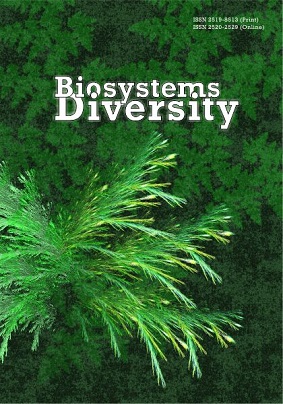Chromosomal rearrangements caused by gamma-irradiation in winter wheat cells
Chromosomal rearrangements caused by gamma-irradiation in winter wheat cells
Author(s): O. O. Izhboldin, M. M. NazarenkoSubject(s): Sociobiology, Environmental interactions
Published by: Дніпропетровський національний університет імені Олеся Гончара
Keywords: chromosomal aberrations; gamma-rays; wheat; genotype;
Summary/Abstract: In this article we report the results of our investigation into several cytogenetic parameters of variability in mutation induction of modern winter wheat varieties and some connections between the means of cytogenetic indices and different doses of gamma-rays. Analysis of chromosomal aberrations following the action of any kind of mutagen by the anaphases method is one of the most widely investigated and most precise methods which can be used to determine the fact of mutagenic action on plants and identify the nature of the mutagen. We combined in our investigation the sensitivity of genotype to mutagen using cytological analysis of mutagen treated wheat populations with the corresponding different varieties by breeding methods to reveal its connections and differences, specific sensitivity to mutagens action on the cell level. Dry seeds of 8 varieties of winter wheat were subjected to 100, 150, 200, 250 Gy gamma irradiation, which are trivial for winter wheat mutation breeding. We investigated rates and spectra of chromosomal aberrations in the cells of winter wheat primary roots tips. The coefficients of correlations amid the rate of chromosomal aberrations and the dose of gamma-rays were on the level 0.8–0.9. The fragments/bridges ratio is a clear and sufficient index for determining the nature of the mutagen agent. We distinguished the following types of chromosomal rearrangements: chromatid and chromosome bridges, single and double fragments, micronuclei, and delayed chromosomes. The ratio of chromosomal aberrations changes with the change in mutagen; note that bridgetypes are characteristic of irradiation. Radiomutants are more resistant to gamma rays. This is apparent in the lower rate of chromosomal aberrations. Varieties obtained by chemical mutagenesis (varieties Sonechko, Kalinova) are more sensitive to gamma-irradiation than others. We propose these varieties as objects for a mutation breeding programme and radiation of mutants for planting in areas subject to the action of gamma-rays.
Journal: Biosystems Diversity
- Issue Year: 25/2017
- Issue No: 1
- Page Range: 25-28
- Page Count: 4
- Language: English

